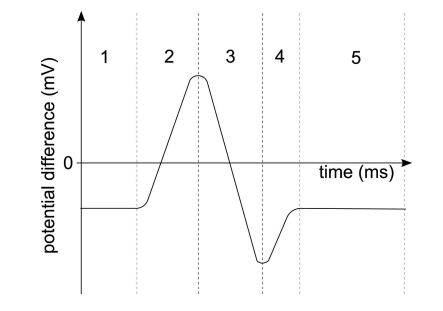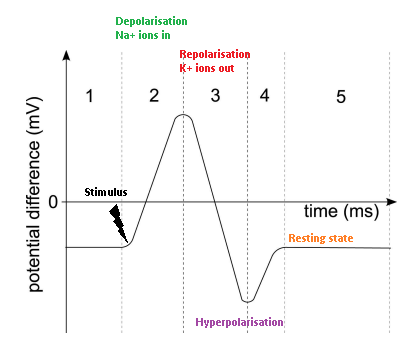The diagram shows the change in potential difference (pd) across the cell surface membrane of a sensory neurone. During which one of the phases (1–5) are the Na+ gates of the neurone open?

A. 1
B. 3
C. 4
D. 2
E. 5
The diagram shows the change in potential difference (pd) across the cell surface membrane of a sensory neurone. During which one of the phases (1–5) are the Na+ gates of the neurone open?

A. 1
B. 3
C. 4
D. 2
E. 5
The correct answer is D.
To understand this question, we have to know what a resting and action potential are.
What is a resting potential ?
It is the difference of electric potential between the 2 sides, outer and inner sides, of the cell membrane. Such electrical difference exists due to the difference of concentration of ions on either side of the membrane.
At the resting state, the resting potential is negative (-70 mV) : the inside of the cell is negatively charged compared to the outside of the cell.
The ions responsible for the resting potential are : K+, Na+, Ca ++, Cl- and HCO3-.

What is an action potential ?
An action potential is the inversion of the polarity of the cell membrane caused by a stimulus that is strong enough to surpass the resting threshold ( between –50 and –55 mV).
It can be divided into different phases :

depolarisation : Na+ channels open and let Na+ molecules inside the cell, making it less negative = in green or number 2
repolarisation : K+ channels open and let the K+ ions outside of the cell, making the inside of the cell negatively charged again = in red or number 3
hyperpolarization : K+ channels are still open while Na+ channels are closed. This makes the inside of the cell more negatively charged than it was in the resting state = in purple or number 4.
resting state = in orange or number 5
Therefore, number 2 is the depolarisation phase, which is caused by the opening of the Na+ gates.